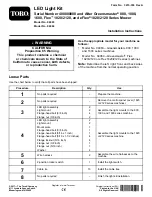
9
Starting the Engine
The blades turn when you start the engine. Start the engine in a clear
or mowed area where the blades can turn freely.
1. Turn the fuel valve to the ON position (
2. Pull back on the blade control lever and hold it against the
handlebar.
3. Start the engine using the electric starter or the recoil (manual)
starter.
Electric start:
Turn the starter key switch to the
START position. Let the key
return to the RUN position when
the engine starts.
The starter should not be cranked
for more than 5 seconds at a
time. If the engine fails to start,
release the switch and wait 10
seconds before operating the
starter again.
If the battery does not have
sufficient charge to start the engine, possibly due to a long
storage period, use the recoil starter to start the engine for at
least one mowing session. The battery should have sufficient
charge after one mowing session (approximately 1 hr).
Manual start:
Pull the starter grip lightly until you feel resistance, and then pull
briskly. Return the starter grip gently.
To ensure easy restarting and maximum performance from the Auto
Choke System™, allow the engine to run for at least three minutes
after starting a cold engine before stopping the engine. This minimum
run time will be longer if the temperature is below 70°F (21°C).
Continue to hold the blade control lever against the handlebar; the
engine stops when the blade control lever is released.
Stopping the Engine
1. Release the blade control lever to stop the engine.
2. When you finish mowing, turn the fuel valve OFF.
3. If your mower will not be used for 3 to 4 weeks, we recommend
running the engine’s carburetor out of fuel. You can do this by
leaving the fuel valve OFF, restarting the engine and running it
until the engine stops. See “FUEL SYSTEM MAINTENANCE” on
if you don’t plan to use your mower for a month or more.
4. Clean your mower after each mowing; refer to “Cleaning” on
SERVICING YOUR MOWER
Proper maintenance is essential for safe, economical, and
trouble-free operation. It also helps reduce air pollution.
To help you properly care for your mower, the following pages include
a maintenance schedule, routine inspection procedures, and simple
maintenance procedures using basic hand tools. Other service tasks
that are more difficult or require special tools are best handled by
professionals and are normally performed by a Honda technician or
other qualified mechanic.
The maintenance schedule applies to normal operating conditions. If
you operate your mower under severe conditions, such as sustained
high load, high temperature, or unusually wet or dusty conditions,
consult your servicing dealer for recommendations applicable to your
individual needs and use.
Remember that an authorized Honda servicing dealer knows your
mower best and is fully equipped to maintain and repair it. To ensure
the best quality and reliability, use only new, Honda Genuine parts or
their equivalents for repair and replacement.
Maintenance, replacement, or repair of the emission control
devices and systems may be performed by any engine repair
establishment or individual, using parts that are “certified” to
EPA standards.
Maintenance Safety
Some of the most important safety precautions follow. However, we
cannot warn you of every conceivable hazard that can arise in
performing maintenance. Only you can decide whether or not you
should perform a given task.
START
RUN
WARNING
Improper maintenance, or failure to correct a problem before
operation, can cause a malfunction in which you can be
seriously hurt or killed.
Always follow the inspection and maintenance
recommendations and schedules in this owner’s manual.
WARNING
Failure to properly follow maintenance instructions and
precautions can cause you to be seriously hurt or killed.
Always follow the procedures and precautions in this manual.










































